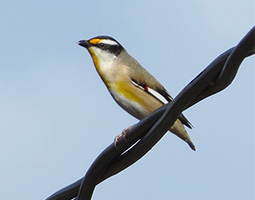Pardalotus striatus
Description

This small, short-tailed bird, found throughout most of Australia except the most arid places, prefers any habitat with trees or shrubs, particularly eucalypt forests and woodlands. While brightly coloured, it is considered the plainest of the four pardalote species. Although the characteristics vary across its range, all birds have a black crown, white eyebrows and a yellow spot in front of the eye. The body is green-grey with a yellow throat, wings are black with a white stripe and either red or yellow spot. Males and females are similar in appearance, with juveniles bearing slightly paler colours.
Breeding occurs from June to February in a nest made of bark fibre, rootlets and fine grass, in a tree hollow, tunnel on the ground or crevices in manmade objects. They lay two to five white, oval-shaped eggs, which both parents, or small groups of up to six birds, help to incubate and feed when hatched. They fiercely defend the opening of the nest.
The call of the Striated Pardalote is a loud 'chip, chip, chip'.
Adaptations
- During breeding season, Striated Pardalotes form pairs or small groups of up to six birds, to help defend, incubate and feed the young
Feeding relationships
- What I eat: Insects and their larvae; nectar
- What eats me: Raptors, Snakes, Small carnivorous mammals (e.g. quoll), feral cats
Interesting facts
Called Wirrwirr in the Yuwaalayaay language, the movements of the Striated Pardalote are complex, as some populations undertake remarkable migratory journeys, while others remain in the same area throughout the year.
Source: Birdlife Australia, Atlas of Living Australia, Birds in Backyards